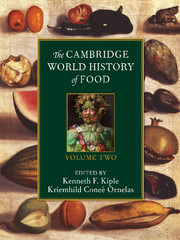Book contents
- Frontmatter
- Part V Food and Drink around the World
- Part VI History, Nutrition, and Health
- Part VII Contemporary Food-Related Policy Issues
- VII.1 The State, Health, and Nutrition
- VII.2 Food Entitlements
- VII.3 Food Subsidies and Interventions for Infant and Child Nutrition
- VII.4 Recommended Dietary Allowances and Dietary Guidance
- VII.5 Food Labeling
- VII.6 Food Lobbies and U.S. Dietary Guidance Policy
- VII.7 Food Biotechnology: Politics and Policy Implications
- VII.8 Food Safety and Biotechnology
- VII.9 Food Additives
- VII.10 Substitute Foods and Ingredients
- VII.11 Nonfoods as Dietary Supplements
- VII.12 Food Toxins and Poisons from Microorganisms
- VII.13 The Question of Paleolithic Nutrition and Modern Health: From the End to the Beginning
- Part VIII A Dictionary of the World’s Plant Foods
- Name Index
- Subject Index
- References
VII.12 - Food Toxins and Poisons from Microorganisms
from Part VII - Contemporary Food-Related Policy Issues
Published online by Cambridge University Press: 28 March 2008
- Frontmatter
- Part V Food and Drink around the World
- Part VI History, Nutrition, and Health
- Part VII Contemporary Food-Related Policy Issues
- VII.1 The State, Health, and Nutrition
- VII.2 Food Entitlements
- VII.3 Food Subsidies and Interventions for Infant and Child Nutrition
- VII.4 Recommended Dietary Allowances and Dietary Guidance
- VII.5 Food Labeling
- VII.6 Food Lobbies and U.S. Dietary Guidance Policy
- VII.7 Food Biotechnology: Politics and Policy Implications
- VII.8 Food Safety and Biotechnology
- VII.9 Food Additives
- VII.10 Substitute Foods and Ingredients
- VII.11 Nonfoods as Dietary Supplements
- VII.12 Food Toxins and Poisons from Microorganisms
- VII.13 The Question of Paleolithic Nutrition and Modern Health: From the End to the Beginning
- Part VIII A Dictionary of the World’s Plant Foods
- Name Index
- Subject Index
- References
Summary
The Processes Affecting Toxicity
Rather than undertaking a categoric examination of the myriad toxins in food, this essay highlights various considerations that should provide a sense of perspective in viewing toxins as a whole. It is important to realize that toxic substances must negotiate the various degradation and propulsive properties of a gastrointestinal tract in order to be absorbed and exert a harmful effect on the body. The ability of the toxin to be absorbed helps determine the amount of a substance that must be ingested before toxic effects become manifest. Moreover, the handling of ingested toxins by an immature gastrointestinal tract of a premature or term newborn infant may be different from that of the fully developed gastrointestinal tract.
Development of the tract begins during the first 12 weeks of gestation as it matures from a straight tube to one that is progressively convoluted, and the surface area for absorption increases. Over the next six months, the gut acquires a sophisticated immune system and the capacity to digest complex carbohydrates, fats, and proteins. Not all of these mechanisms, however, are fully functional until several months after birth.
The extent to which ingested substances, including food and toxins, are absorbed by the intestine is dependent on the capabilities it has developed to deal with carbohydrates, fats, proteins, water, and ions. These are highly complex issues about which varying amounts of information are understood. Nevertheless, a general concept of how absorption occurs may help put the discussion of food toxins in context.
- Type
- Chapter
- Information
- The Cambridge World History of Food , pp. 1694 - 1703Publisher: Cambridge University PressPrint publication year: 2000

